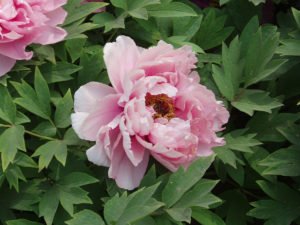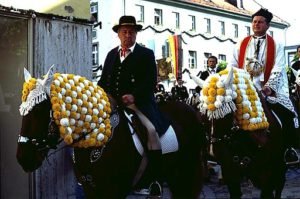
Therese Weiss
The Stuttgart Citizen
Pentecost (also called Whitsunday) is always celebrated on the seventh Sunday after Easter. This spring, the feast day of the Holy Spirit is on May 20 and marks the documented start or real “birthday” of the Christian church.
The word “Pentecost” and the German “Pfingsten” are both derived from the Greek “pentekoste,” the 50th day after Easter. Ever since the early fourth century, this holiday commemorates the descent of the Holy Spirit upon the Apostles after Christ’s resurrection and ascension.
In Germany, Pentecost is a high church holiday and is celebrated on two successive days. For people who know little about Pentecost or other religious festivities, the double holiday on Sunday and Monday, is merely another welcome opportunity for resting, for family gatherings and outdoor events on this long weekend..
However, there are a number of charming local and regional customs tied to this springtime feast. Already during the Middle Ages, noble and royal marriages, knights’ jousting tournaments, riding competitions and aristocratic events were held with great pomp on Pentecost .
In Baden-Wuerttemberg and elsewhere in southwest Germany, some old and re-discovered traditions are thriving again, such as decorating houses, barns, chapels and churches with fresh-cut greenery, branches and birch twigs, and adorning rooms with flags, red ribbons and flowers the color of Pentecost.

One old Swabian custom related to Pentecost is the so-called “Pfingstritt”, formal horseback rides through the meadows and fields and forming riders’ processions. It is a big event on Pentecost Monday afternoon for the townspeople wherever it is still done and quite an attraction for tourists, such as in Wurmlingen (near Tubingen) .
For a Flurumritt (ride through the fields), horsemen assemble in the market square and then trot around the fields nearby. In predominately Catholic towns, the parish priest accompanies the horsemen with acolytes carrying banners. People chant traditional festive hymns and religious songs, adding solemnity to the procession that concludes with the priest blessing the fields and requesting God’s help for another year’s bountiful crop growth.
At church services, singing Pentecost hymns is central to the celebration in the Western tradition such as Martin Luther’s “Komm, Heiliger Geist, Herre Gott” (Come, Holy Spirit, God and Lord), or Hildegard von Bingen’s “O Holy spirit, Root of Life” and “Veni Sancte Spiritus“.
In past times, popular superstitions about Pentecost revolved around certain herbs, plants and even flowers. For example, the calendula or Ringelblume was believed to have curative powers if picked on Whitsunday morning at sunrise – or that face-washing with Pentecost dew would prevent freckles! It was also hoped that water, scooped up from wells or brooks at this time would heal the sick, or that lighting one’s candle from a Pentecost bonfire would dispel evil spirits.
These customs have been maintained for centuries because people nostalgically enjoy them or because they believe in their familiar value. In our modern, secular and fast-paced world, Pentecost traditions are a welcome mainstay and comforting respite.
